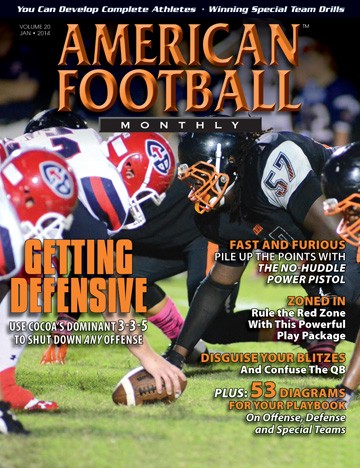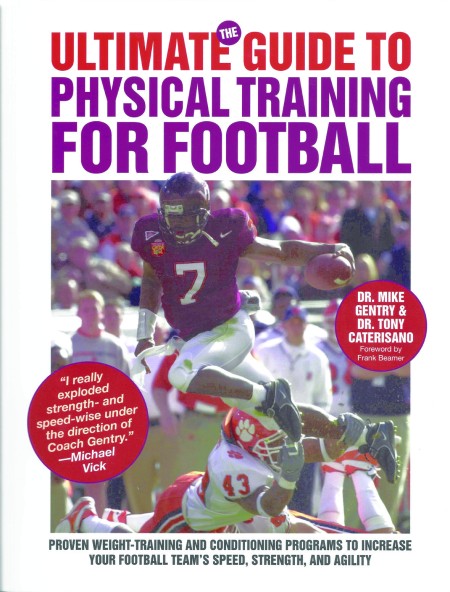Article CategoriesAFM Magazine
|
DEVELOPING THE COMPLETE ATHLETE© More from this issueMike Gentry, the Associate Athletic Director for Athletic Performance at Virginia Tech and Dr. Tony Caterisano, a Professor of Health and Exercise Science, have written a comprehensive guide for the strength and conditioning development of the complete football player. This 436-page book details how a coach can build overall power and stamina in athletes as well as develop self-discipline in maximizing athletic potential. What exactly makes one player more athletic than another? Is it something that can be coached or are great athletes born rather than made? To answer these questions we must look not only at research studies, but also common practices of the players and coaches who work to improve themselves every day. Whenever a coach sees the overlap of theory and practice, he can be sure that there is good information regarding sound training principles. Based on our experience, we have observed that athleticism is something that can be developed and improved within each playerís genetic limitation. To achieve optimum performance that carries over to the game, we must understand the relationship among four basic factors that make a difference in the athletic ability of a football player. The four components of athleticism are: 1) strength and increased lean body mass, 2) power, 3) speed and acceleration, and 4) quickness and agility. Strength is defined as the capacity to generate a maximum amount of force through muscle contraction with no time limits. This time factor becomes very important in distinguishing the difference between strength and power. In addition, improving the athleteís body composition, which refers to the ratio of body fat to lean muscle, is an important part of the strength acquisition process. An important form of strength for any athlete, but especially a football player, is what is commonly termed core strength This describes the strength that can be generated by large muscle groups located in the hips, thighs, and torso that stabilize the body, which can affect performance on the field and help prevent injuries. Think of core strength as the foundation of a building. A good building contractor would never build an expensive house on a cheap, substandard foundation. If he did, damage would occur at the weakest point, the foundation, which would be very expensive to repair and weaken the entire structure. Lack of core strength is the most prevalent cause of poor athletic performance and can cause chronic injuries. Core strength and a large amount of lean body mass with a minimal fat mass are important prerequisites for power. Many of the lifts and plyometric techniques used to acquire power are based on maximized strength and a balanced, stable muscle system.
Football is a game of power involving repetitive, explosive bursts of physical activity throughout the game. Power is defined as the ability to generate the greatest amount of force in the shortest period of time. In untrained individuals research shows that increasing strength alone results in an increase in power. One might assume this to be true with well-trained individuals. However, the idea that a high level of strength automatically results in a high level of power is often not the case. A recent study that compared leg strength as measured by the squat and power clean to leg power as measured by vertical and long jump tests among a group of collegiate football players found the relationship between the two to be weak. The results showed that some of the strongest athletes didnít have the best vertical jumps. This is due to the fact that the subjects tested were college-level players who had already established good basic core strength. It demonstrates that the relationship between power and strength is not always proportional, due to a principle called explosive strength deficit which we will discuss later in this chapter. Speed is the application of power, usually most relevant to sprinting, but also related to hand speed and foot speed in a game situation. For example, power applied to the technique of running results in improved running speed. A player can become a faster runner if he develops increased leg power and applies it to proper running mechanics. In addition we believe that there is a distinct difference between maximum running speed and acceleration. Acceleration may be a bigger asset in a football game than maximum speed. Finally, agility is the application of speed to an open-skill type of sport like football. Here the athlete is required to change direction very quickly, accelerate and decelerate. Research suggests that unless speed training includes multiple changes of direction, straight speed work does not have a direct carryover to agility. Coordination, speed, flexibility, and a quick reaction time are the basic precursors of agility and they can be developed to improve agility. Strength, power, speed, and agility are the essence of athleticism and separate the successful athlete from the unsuccessful athlete out on the football field. Developing them with systematic conditioning is the goal we believe will improve your program. It is clear that the development of agility is the ultimate goal of every strength and conditioning program once the playing season is underway, but it is critical that the other three components of athleticism must be targeted in the proper order to build the foundation for an ideal strength and conditioning program. |
|
| HOME |
MAGAZINE |
SUBSCRIBE | ONLINE COLUMNISTS | COACHING VIDEOS |
Copyright 2024, AmericanFootballMonthly.com
All Rights Reserved





